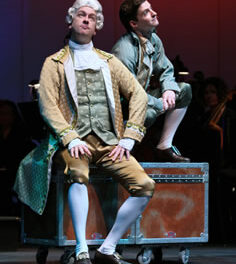North Carolina’s Early Music and Period Performance community seems to be growing. This year the Mallarmé Chamber Players, one of our most capable and influential ensembles, will host the 2016 NC HIP Festival, showcasing some of the state’s finest advocates of Historically-Informed Performance.
The Raleigh Camerata‘s performance at Winston-Salem’s Calvary Moravian Church on Sunday was a preview of their set at NC HIP, and focused on some rare gems from the Moravian Music Foundation‘s collection. Playing on replicas of Baroque and Classical instruments, and using performance techniques informed by historical treatises and research, the Camerata offered a valuable perspective on the repertoire.
Since the 1970s, some astonishing historically-informed and period-instrument practitioners have changed the way classical music audiences hear and interpret music. Names like Ton Koopman, Jordi Savall, and John Eliot Gardiner are nearly household. Occasionally, one of their recordings makes me wonder why we don’t bow gut strings and blow keyless tubes all the time.
But the truth is that these great recordings are documents of hard-won and somewhat lucky moments in time. Period instruments can be fickle, shimmering one moment and squawking the next. The Raleigh Camerata’s concert began with a reminder that the evolution of instruments wasn’t all bad: just a few bars into the opening John Antes Trio No. 2, one of the pegs on Christopher Nunnally‘s cello slipped, lowering its string’s pitch down to a flappy growl. (I’m sure there’s a joke to be made here about historical tunings being lower.)
But with calm and ease these consummate professionals paused to retune, and proceeded to demonstrate all the truly great things about early instruments. Bowed gut strings have a magical sound, somewhat less robust than steel, but more transparent. The overtones seem always just on the verge of breaching the sonic surface, creating a shimmering and multi-hued timbre.
The interplay between Leah Peroutka and Allison Willet‘s violins was fascinating, a more textured and delicate harmony than we’re used to from contemporary loud, sweet violins. Nunnally’s freshly tuned cello danced nimbly through the bass lines, while Jennifer Streeter‘s sparkling harpsichord filled out the harmonies. Any lingering doubts about the peg slip were dispelled, and with every note the musicians seemed to say, “this is why we play these instruments!” What a spectacular sonic show of delicacy, detail, rhythm, articulation, and shimmer.
Next the group moved to the wind side of the spectrum with a Duet in D, attributed to Matthias Stabinger but probably by Jakob Kleinknecht.
Throughout the concert, each performer took a moment to describe her/his instrument to the audience. The duet gave artistic director Kelly Roudabush a chance to show off her lovely 8-key flute and describe its differences from modern examples. Joining her on 2-key Baroque oboe was Tom Turanchik, who would wait until later in the program to explain what he called his “noisy stick.” The oboe’s past life was indeed noisy. This intractable instrument, at its best, produced a beautifully thick tone somewhat like a soft trumpet. Turanchik, like a lion tamer or dragon slayer, heroically battled the instrument’s obvious unwillingness to speak well and in tune. But if the musicians are up for the adventure, then we should be also. The dainty duet became a dramatic poem, punctuated by moments of sheer beauty as flute and oboe came together harmoniously.
The entire concert, as stated previously, used music from the Moravian Music Foundation’s collections. During the second half, the ensemble went a step further, focusing on music available only in the Moravian Collection.
They began with Johann Graun’s Trio in A, a piece available elsewhere but not in this particular arrangement.
The highlight of the concert was Ignaz Pleyel’s Quartet No. 1 in G, originally for standard string quartet and arranged here by François Devienne for flute and strings. With Joey O’Donnell joining in on Baroque viola, everything came together. The ending of the second movement, the Adagio “con sordino” (“with mutes”), was the very pinnacle of musicianship. I thought I could hear and feel every mote of dust floating in Calvary Moravian as the players softly repeated the closing chord.
The closing Rondo punctuated the concert with lively elegance, and the audience didn’t hesitate to jump up and express their enthusiasm.
Historically-Informed Performance can be an adventure, but it’s one well worth taking. If you’re up for the sonic ride, I highly recommend exploring the 2016 NC HIP Festival, and hearing what these fine musicians and their colleagues have to offer. Bravi!











